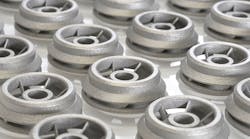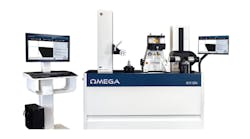Additive manufacturing specialist The ExOne Company is developing a 3D-printing pod under a U.S. Dept. of Defense contract, aiming to create a “fully operational, self-contained” operation housed in a shipping container. The $1.6-million Defense Logistics Agency order seeks a ruggedized binder-jet 3D printer in a standard shipping container up to 40 feet long, which could be deployed by land, sea, or air to manufacture parts in combat zones, for disaster relief, or other remote locations.
In concept, the 3DP pod would allow military personnel to print a digital file of a damaged part and have a finished product in less than 48 hours, without conventional tooling. A digital library of parts for 3D printing can be stored electronically. When a digital file is unavailable, the item would be 3D-scanned and printed on location.
Parts needed to address particular problems also could be designed digitally and 3D-printed, as needed.
ExOne’s 3D printers produce parts in more than 20 metal, ceramic or composite materials. They also print sand molds. ExOne said it is developing a “military-edition” system capable of binder-jet printing more than 20 metal, ceramic, and other powder materials into final products or tooling. The upgraded, commercial-grade 3D-printer will have a novel body style and other details that will make it military-grade.
A further goal is to simplify the printer’s operation with adapted software and training, for a wide range of operating conditions, without diminishing final part quality. The project seeks to simplify how the technology is used in the field, so the pod can be used with minimal technical knowledge.
"Binder jet 3D printing is a critical manufacturing technology for military use because of its speed, flexibility of materials, and ease of use," stated ExOne CEO John Hartner.
ExOne is collaborating with Dynovas Inc., a specialist in materials engineering and composites manufacturing for weapons systems; and with Applied Composites – San Diego, a supplier of complex composite parts, assemblies, and tooling for aerospace and defense systems. AC-SD’s Reinforced Additively Manufactured Compression Assisted Molding (RAMCAM) system is described as “an enabler” to the 3DP pod project.
"We’re excited to collaborate with the U.S. Department of Defense and other partners to make our 3D printers more rugged for the military, which will also benefit our other manufacturing customers. Most importantly, we know that years from now, our technology will play an important role in filling critical needs quickly."







